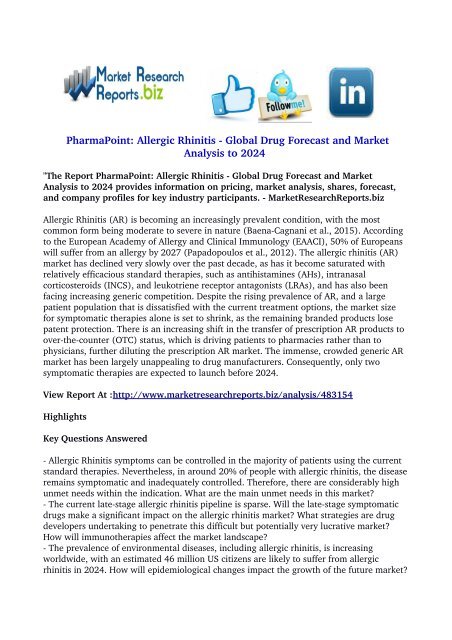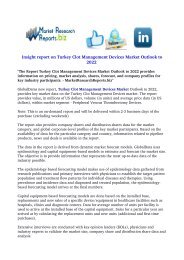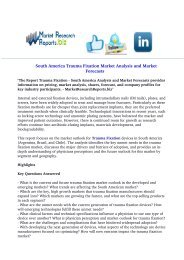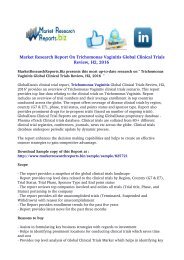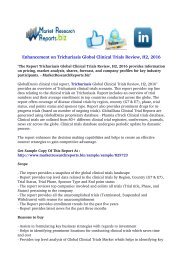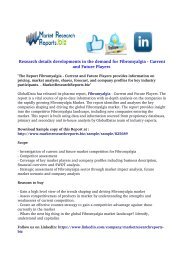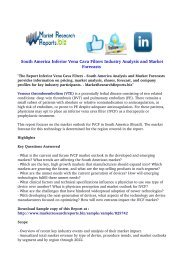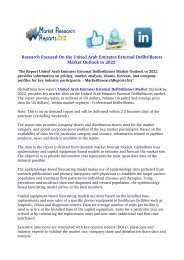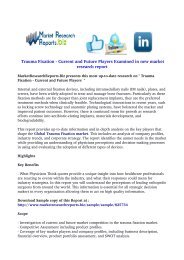PharmaPoint: Allergic Rhinitis - Global Drug Forecast and Market Analysis to 2024
Create successful ePaper yourself
Turn your PDF publications into a flip-book with our unique Google optimized e-Paper software.
<strong>PharmaPoint</strong>: <strong>Allergic</strong> <strong>Rhinitis</strong> <strong>Global</strong> <strong>Drug</strong> <strong>Forecast</strong> <strong>and</strong> <strong>Market</strong><br />
<strong>Analysis</strong> <strong>to</strong> <strong>2024</strong><br />
"The Report <strong>PharmaPoint</strong>: <strong>Allergic</strong> <strong>Rhinitis</strong> <strong>Global</strong> <strong>Drug</strong> <strong>Forecast</strong> <strong>and</strong> <strong>Market</strong><br />
<strong>Analysis</strong> <strong>to</strong> <strong>2024</strong> provides information on pricing, market analysis, shares, forecast,<br />
<strong>and</strong> company profiles for key industry participants. <strong>Market</strong>ResearchReports.biz<br />
<strong>Allergic</strong> <strong>Rhinitis</strong> (AR) is becoming an increasingly prevalent condition, with the most<br />
common form being moderate <strong>to</strong> severe in nature (BaenaCagnani et al., 2015). According<br />
<strong>to</strong> the European Academy of Allergy <strong>and</strong> Clinical Immunology (EAACI), 50% of Europeans<br />
will suffer from an allergy by 2027 (Papadopoulos et al., 2012). The allergic rhinitis (AR)<br />
market has declined very slowly over the past decade, as has it become saturated with<br />
relatively efficacious st<strong>and</strong>ard therapies, such as antihistamines (AHs), intranasal<br />
corticosteroids (INCS), <strong>and</strong> leukotriene recep<strong>to</strong>r antagonists (LRAs), <strong>and</strong> has also been<br />
facing increasing generic competition. Despite the rising prevalence of AR, <strong>and</strong> a large<br />
patient population that is dissatisfied with the current treatment options, the market size<br />
for symp<strong>to</strong>matic therapies alone is set <strong>to</strong> shrink, as the remaining br<strong>and</strong>ed products lose<br />
patent protection. There is an increasing shift in the transfer of prescription AR products <strong>to</strong><br />
overthecounter (OTC) status, which is driving patients <strong>to</strong> pharmacies rather than <strong>to</strong><br />
physicians, further diluting the prescription AR market. The immense, crowded generic AR<br />
market has been largely unappealing <strong>to</strong> drug manufacturers. Consequently, only two<br />
symp<strong>to</strong>matic therapies are expected <strong>to</strong> launch before <strong>2024</strong>.<br />
View Report At :http://www.marketresearchreports.biz/analysis/483154<br />
Highlights<br />
Key Questions Answered<br />
<strong>Allergic</strong> <strong>Rhinitis</strong> symp<strong>to</strong>ms can be controlled in the majority of patients using the current<br />
st<strong>and</strong>ard therapies. Nevertheless, in around 20% of people with allergic rhinitis, the disease<br />
remains symp<strong>to</strong>matic <strong>and</strong> inadequately controlled. Therefore, there are considerably high<br />
unmet needs within the indication. What are the main unmet needs in this market?<br />
The current latestage allergic rhinitis pipeline is sparse. Will the latestage symp<strong>to</strong>matic<br />
drugs make a significant impact on the allergic rhinitis market? What strategies are drug<br />
developers undertaking <strong>to</strong> penetrate this difficult but potentially very lucrative market?<br />
How will immunotherapies affect the market l<strong>and</strong>scape?<br />
The prevalence of environmental diseases, including allergic rhinitis, is increasing<br />
worldwide, with an estimated 46 million US citizens are likely <strong>to</strong> suffer from allergic<br />
rhinitis in <strong>2024</strong>. How will epidemiological changes impact the growth of the future market?
Key Findings<br />
The main driver of growth in the AR market will be the introduction of several AIT<br />
tablets: Mercks Grastek (grass), Ragwitek (ragweed), <strong>and</strong> Mitizax (house dust mite [HDM])<br />
tablets, as well as Greers Oralair (grass) in the US. These new products overcome the<br />
inconvenience of conventional subcutaneous immunotherapies (SCITs).<br />
The major global barrier for the AR market will be the increasing push for patients <strong>to</strong> selfmedicate<br />
using OTC drugs will decrease the prescription AR drug market size.<br />
There is little room for new entrants, as the market is wellserved by a wealth of<br />
symp<strong>to</strong>matic therapies. Since the competition is increasing, the market for AR therapies is<br />
becoming increasingly less lucrative. Also, there are currently no breakthrough<br />
symp<strong>to</strong>matic therapy products in clinical development.<br />
The remaining clinical unmet needs in this market include the requirement for more<br />
efficacious products, <strong>and</strong> the underserved area of causative therapies, such as<br />
immunotherapies, which target the underlying cause of the disease.<br />
Download Sample copy of this Report at<br />
http://www.marketresearchreports.biz/sample/sample/483154<br />
Scope<br />
Overview of AR, including epidemiology, etiology, pathophysiology, symp<strong>to</strong>ms, diagnosis,<br />
<strong>and</strong> treatment guidelines.<br />
Annualized AR therapeutics market revenue, annual cost of therapy <strong>and</strong> treatment usage<br />
pattern data from 2014 <strong>and</strong> forecast for ten years <strong>to</strong> <strong>2024</strong>.<br />
Key <strong>to</strong>pics covered include strategic competi<strong>to</strong>r assessment, market characterization,<br />
unmet needs, clinical trial mapping <strong>and</strong> implications for the AR therapeutics market.<br />
Pipeline analysis: comprehensive data split across different phases, emerging novel trends<br />
under development, <strong>and</strong> detailed analysis of latestage pipeline drugs.<br />
<strong>Analysis</strong> of the current <strong>and</strong> future market competition in the global AR therapeutics<br />
market. Insightful review of the key industry drivers, restraints <strong>and</strong> challenges. Each trend<br />
is independently researched <strong>to</strong> provide qualitative analysis of its implications.<br />
Reasons <strong>to</strong> buy<br />
Develop <strong>and</strong> design your inlicensing <strong>and</strong> outlicensing strategies through a review of<br />
pipeline products <strong>and</strong> technologies, <strong>and</strong> by identifying the companies with the most robust<br />
pipeline. Additionally a list of acquisition targets included in the pipeline product company<br />
list.<br />
Develop business strategies by underst<strong>and</strong>ing the trends shaping <strong>and</strong> driving the global<br />
AR therapeutics market.<br />
Drive revenues by underst<strong>and</strong>ing the key trends, innovative products <strong>and</strong> technologies,<br />
market segments, <strong>and</strong> companies likely <strong>to</strong> impact the global AR therapeutics market in<br />
future.<br />
Formulate effective sales <strong>and</strong> marketing strategies by underst<strong>and</strong>ing the competitive<br />
l<strong>and</strong>scape <strong>and</strong> by analysing the performance of various competi<strong>to</strong>rs.<br />
Identify emerging players with potentially strong product portfolios <strong>and</strong> create effective<br />
counterstrategies <strong>to</strong> gain a competitive advantage.<br />
Track drug sales in the global AR therapeutics market from 2014<strong>2024</strong>.<br />
Organize your sales <strong>and</strong> marketing efforts by identifying the market categories <strong>and</strong>
segments that present maximum opportunities for consolidations, investments <strong>and</strong> strategic<br />
partnerships.<br />
Table of Contents<br />
1 Table of Contents 12<br />
1.1 List of Tables 18<br />
1.2 List of Figures 21<br />
2 Introduction 22<br />
2.1 Catalyst 22<br />
2.2 Related Reports 23<br />
2.3 Upcoming Related Reports 23<br />
3 Disease Overview 24<br />
3.1 Etiology <strong>and</strong> Pathophysiology 24<br />
3.2 Symp<strong>to</strong>ms 27<br />
3.3 Classification 28<br />
3.3.1 Seasonal <strong>and</strong> Perennial AR 28<br />
3.3.2 ARIA Classification of AR 28<br />
3.4 Diagnosis 29<br />
3.5 Quality of Life 31<br />
4 Epidemiology 32<br />
4.1 Disease Background 32<br />
4.2 Risk Fac<strong>to</strong>rs <strong>and</strong> Comorbidities 33<br />
4.2.1 A family his<strong>to</strong>ry of AR is a strong predic<strong>to</strong>r for AR in children <strong>and</strong> adults 34<br />
4.2.2 Exposure <strong>to</strong> allergens in the environment increases the risk for AR 35<br />
4.2.3 Urban living elevates the risk for AR 35<br />
4.2.4 Comorbidities 36<br />
4.3 <strong>Global</strong> <strong>and</strong> His<strong>to</strong>rical Trends 38<br />
4.3.1 US 38<br />
4.3.2 5EU 39<br />
4.3.3 Japan 40<br />
4.4 <strong>Forecast</strong> Methodology 41<br />
4.4.1 Sources Used 43<br />
4.4.2 Sources Not Used 46<br />
4.4.3 <strong>Forecast</strong> Assumptions <strong>and</strong> Methods 46<br />
4.5 Epidemiological <strong>Forecast</strong> for AR (20132023) 49<br />
4.5.1 Total Prevalent Cases of AR 49<br />
4.5.2 AgeSpecific Total Prevalent Cases of AR 51<br />
4.5.3 SexSpecific Total Prevalent Cases of AR 53<br />
4.5.4 AgeSt<strong>and</strong>ardized Total Prevalence of AR 55<br />
4.5.5 Distribution of Total Prevalent Cases of AR by Severity 57<br />
4.5.6 Distribution of Total Prevalent Cases of AR by Type 58<br />
4.5.7 Distribution of Total Prevalent Cases of AR Sensitized <strong>to</strong> Specific Allergens 59<br />
4.6 Discussion 60<br />
4.6.1 Epidemiological <strong>Forecast</strong> Insight 60<br />
4.6.2 Limitations of the <strong>Analysis</strong> 60<br />
Follow us on LinkedIn: https://www.linkedin.com/company/marketresearchreportsbiz
About us<br />
<strong>Market</strong>ResearchReports.biz is the most comprehensive collection of market research<br />
reports. <strong>Market</strong>ResearchReports.Biz services are specially designed <strong>to</strong> save time <strong>and</strong> money<br />
for our clients. We are a one s<strong>to</strong>p solution for all your research needs, our main offerings<br />
are syndicated research reports, cus<strong>to</strong>m research, subscription access <strong>and</strong> consulting<br />
services. We serve all sizes <strong>and</strong> types of companies spanning across various industries.<br />
Contact<br />
Mr. Nachiket<br />
State Tower<br />
90 Sate Street, Suite 700<br />
Albany, NY 12207<br />
Tel: +15186212074<br />
Website: http://www.marketresearchreports.biz/<br />
E: sales@marketresearchreports.biz


